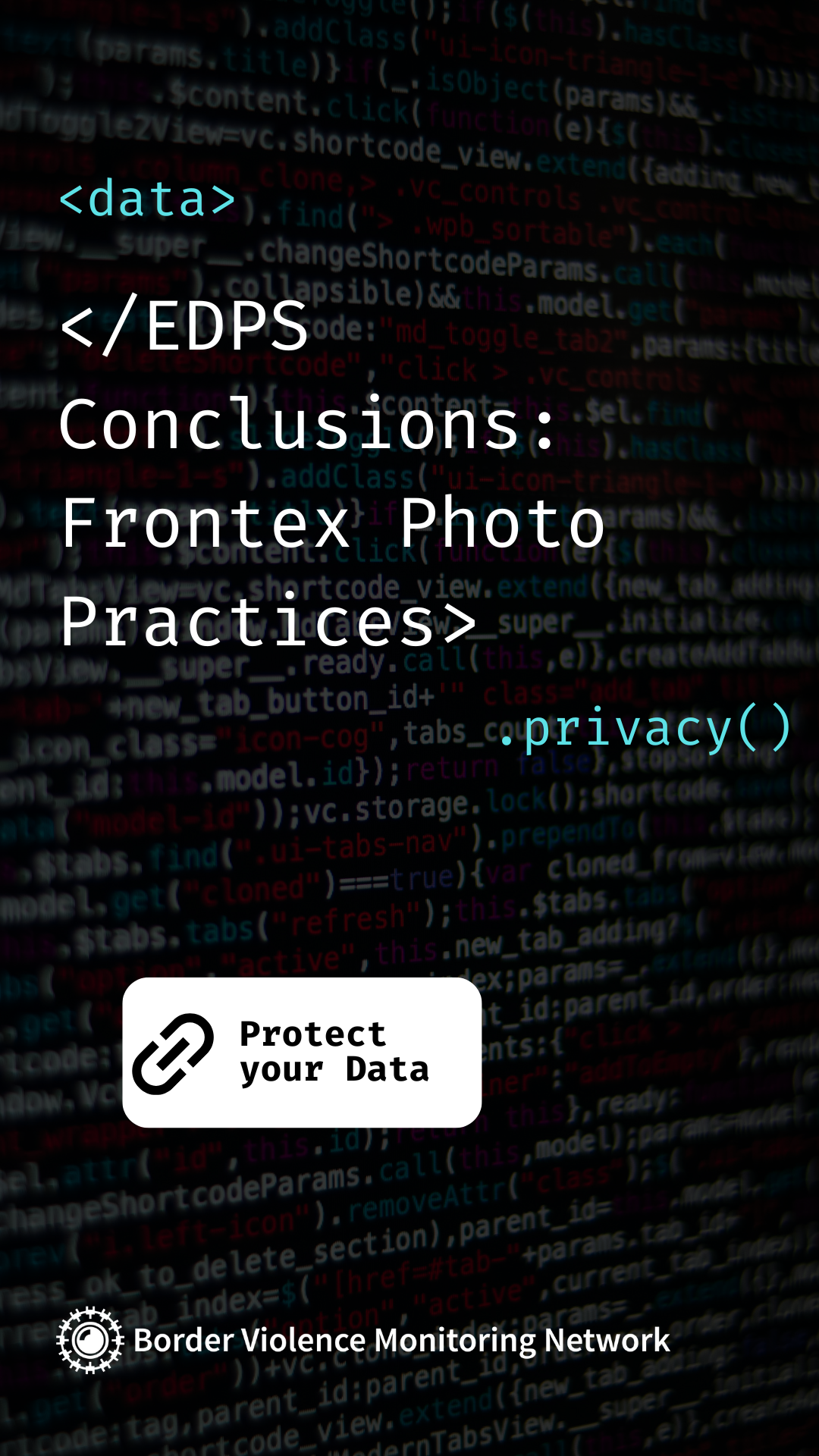The European Data Protection Supervisor has determined that Frontex faces potential breaches of the EU General Data Protection Regulation if its officers are not expressly forbidden from capturing photographs of third-country nationals intercepted at borders. The EDPS issued recommendations to the Agency to develop a clear internal policy that makes clear that photographing outside an identification procedure is unlawful. The EDPS conducted a pre-investigation after the matter was referred to by Border Violence Monitoring Network.
Border Violence Monitoring Network (BVMN) has recorded between 2019 to 2021 a number of instances where respondents stated they were photographed upon interception by Frontex officers with personal mobile devices. BVMN testimonies record the incidents which are a violation of the General Data Protection Regulation (EU GDPR). The matter was promptly referred to the Frontex Data Protection Officer (DPO).
The DPO commenced her investigation into the referred matter. After some delays in conducting her investigation due to “the substantial scarcity of resources” (according to her reply), the DPO of Frontex stated that she was able to narrow down the research to two potential individuals in one case. However, by the time the issue was brought to her attention, the officers were no longer deployed with Frontex and her mandate was limited, leaving her without the possibility to interview them. The DPO stated that she will issue recommendations to the unit responsible for joint operations, but that, again, her mandate limits the possibility “to crystallise it in a comprehensive document”.
BVMN then referred the issue to the European Data Protection Supervisor (EDPS) who started a pre-investigation. BVMN raised issues regarding both Frontex officers’ practices in photographing people on the move with personal devices, as well as the limited mandate and resources of the DPO of Frontex in investigating GDPR violations.
The EDPS concluded its pre-investigative phase stating that there was insufficient evidence and information to conduct an investigation at this stage. However, it has identified risks regarding a lack of coherent policy and a clear prohibition by Frontex to photograph people on the move outside identification procedures.
The EDPS issued Frontex with a set of recommendations to develop and integrate a clear policy clearly prohibiting such practices and to review the procedure regarding investigations conducted by the Frontex DPO, including internal support and resources for her to be able to fulfill her mandate.
For more information see below the relevant BVMN testimonies and read the response from the EDPS.
| From-
to |
Date | Location | Description | Nationality | Quote | Other | Link | |
| 1 | Greece- Turkey | 03.09.2021 | Evros River | One of the officers spoke Arabic in Syrian dialect. The Turkish, Arabic and Greek officers communicated with each other in sign language as they did not speak the same language. | ? | The officers took pictures on their phone of all members of the group, but did not fingerprint them or register any asylum claim. After climbing out of the river on the Turkish side the group walked for 3 or 4km to the village of Yenikadin. | Link | |
| 2 | Aegean Sea | 24.08.2021 | 3km Samos Island | 7 officers – all men, wearing black balaclavas, dressed in dark uniforms bearing the EU flag; some spoke English
medium-sized boat in gray and white colors, with no signs, just numbers |
? | No fingerprints or individual pictures were taken at any time. The only information collected was one picture of the 37 people. The respondent personally expressed his intention to apply for asylum in Greece, but was only met with insulting and screaming words by the officers. “Every time we tried to talk to them, they insulted us and screamed at us”. | Sea push back | Link |
| 3 | Greece- TurkeyEvros River | 25.06.2021 | Lavara/Alibey | eight officers wearing black uniforms and brown camouflage uniforms speaking English
3 white jeeps with “police” written on them in English |
? | The respondent also said, “When they caught us they took a picture of us with their smartphone. They took pictures of the whole group then one of each of us.” The group was not told why they took the pictures. | brought to detention center after | Link |
| 4 | Greece- Turkey | 17.05.2021 | Dilofos/Kapikule | One of the officers was wearing a black uniform and a balaclava. The other one had jeans and a green jacket. There was nothing to suggest that they were police | Two other officers wearing all black came and asked the respondent and his friend to show their faces. They took a picture from them with their phone while they were still handcuffed in the trunk. Those two officers stayed there for about 30 minutes, laughing and smoking. The respondent asserted that those two officers talked to each other in English, and the officer wearing civilian clothes who apprehended them was also talking in English. | Link | ||
| 5 | Albania- Greece | 30.05.2021 | Trestenik | dark blue uniforms, wore a light blue band on the upper arm (visually identified as a Frontex accessory | Slovaninan; Albanian | The Frontex officials asked them why they had entered from Greece and told them that because of the COVID-19 pandemic it was not possible. The officers also took pictures of the groups faces. “They make us photos ‘come with us we take pictures, don’t worry; why you came here? you know Albania is close now problem with corona’” (9 persons) | Link | |
| 6 | Albania- Greece | 31.05.2021 | Trestenik | The Polish and Romanian officers had blue Frontex armbands worn over their national uniforms | Polish; Romanian | The respondent described how the officers questioned them for their identity and how they had crossed. They also took pictures of everyone in the transit group. (9 persons) | Link | |
| 7 | Bulgaria- Turkey | 10.08.2021 | Malko Tarnovo | At the pushback point, the respondent was handed over again to two other officers wearing sage green shirts and pants. They had a green Nissan car which had “border police” written on it in English. | Bulgarian | They took his bag and shoes and took pictures of him with their phones | Link | |
| 8 | Bulgaria- Turkey | 18.07.2021 | Vaysal | The one officer in black did not have the Bulgarian flag but a blue arm band | Bulgarian | The officers did not provide the group with any documents or take their fingerprints but took pictures of them with their phones. They asked the group in English ‘Where are you from Where are you going? Who is the smuggler who is the driver?’ | Link | |
| 9 | Bulgaria- Turkey | 07.05.2021 | Malko Tarnovo to Şükrüpaşa | 14 officers wearing balaclavas & black uniforms – some had the Bulgarian flag on their arms, some were identified as German Frontex officers | German | The officers took pictures of the group with their phones but never asked them to sign any paper, and didn’t take their fingerprints. | Link | |
| 10 | Hungary- Serbia | 30.08.2021 | Road 55 | 8 Police officers (including 2 German speakers), 2 vans (including one with German inscription/Blue emblem); vehicle as displaying a blue logo and the German inscription « Polizei » | German | Once they reached the border point, they were all asked to kneel down. A picture of each of them was taken. Each individual was then ordered to walk through the door that leads to the Serbian side of the border. A Hungarian Police officer filmed the whole process. | Link | |
| 11 | Hungary-Serbia | 06.09.2019 | Röszke | van was driven by the same Hungarian police officers and the German officer who had detected, beaten and detained the transit group | German | Further, while the men were in the water, Hungarian police officers stood around the pool and recorded the transit group with small digital cameras and their cell phones.
“They were standing around the pool and laughing at us and taking pictures.” After what felt like 45 minutes, the people-in-transit were told to get out of the pool |
Link | |
| 12 | Albania-Greece | 12.06.2021 | Bilisht | 2 Frontex officers (declared nationalities: Slovakia and Poland) | Slovak,Polish | The respondent states that he was apprehended by an Albanian officer. He then told them to follow him and they walked towards other officers. There were two foreign officers, identified as Frontex. After being asked by the respondent, one of the Frontex officers identified himself as Slovakian and the other one as Polish. The respondent remembers that the Albanian officers called one of the Frontex officers “Pablo” and addressed him in English.
The respondent interacted with the foreign officers and spoke English with them while waiting for the operation to conclude. He states they talked about football and Slovakian players. The officers were wearing black t-shirts with ‘Police’ written on them. The Albanian officer was in civilian clothing, wearing a blue t-shirt. Asked if he recognized the Frontex armband, the respondent said that none of the officers he encountered wore the armband or other Frontex insignia. The respondent stated that the Frontex officer took photos of him with his phone. (see audio file attached) |

